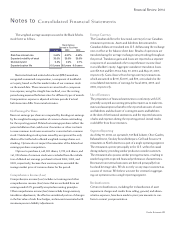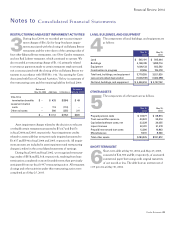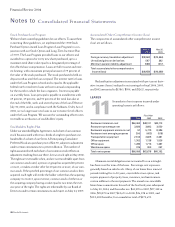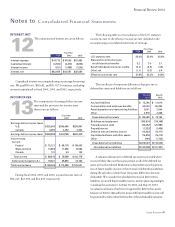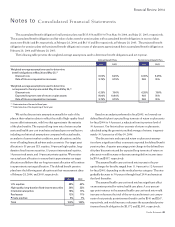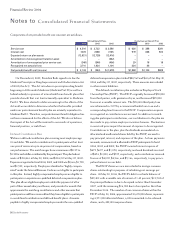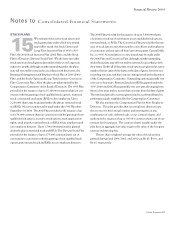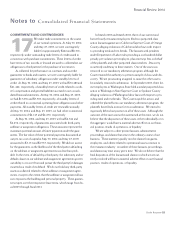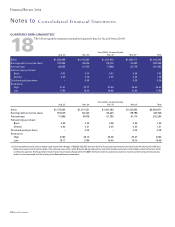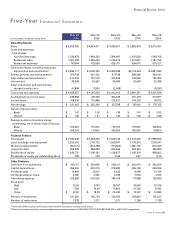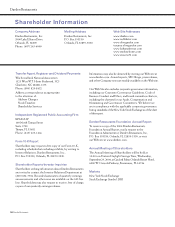Red Lobster 2004 Annual Report Download - page 50
Download and view the complete annual report
Please find page 50 of the 2004 Red Lobster annual report below. You can navigate through the pages in the report by either clicking on the pages listed below, or by using the keyword search tool below to find specific information within the annual report.
50
Components of net periodic benefit cost (income) are as follows:
DefinedBenefitPlans PostretirementBenefitPlan
2004 2003 2002 2004 2003 2002
Servicecost $4,516 $3,732 $3,586 $626 $388 $291
Interestcost 7,076 7,088 7,145 919 648 500
Expectedreturnonplanassets (12,821) (12,739) (12,416) – – –
Amortizationofunrecognizedtransitionasset – – (642) – – –
Amortizationofunrecognizedpriorservicecost (348) (348) (456) 29 18 18
Recognizednetactuarialloss 3,710 1,924 1,104 334 46 –
Netperiodicbenefitcost(income) $2,133 $(343) $(1,679) $1,908 $1,100 $809
Notesto
Consolidated Financial Statements
On December 8, 2003, President Bush signed into law the
Medicare Prescription Drug Improvement and Modernization Act
of 2003 (the Act). The Act introduces a prescription drug benefit
beginning in 2006 under Medicare (Medicare Part D) as well as a
federal subsidy to sponsors of retiree health care benefit plans that
provide a benefit that is at least actuarially equivalent to Medicare
Part D. We have elected to defer accounting for the effects of the
Act until we are able to determine whether the benefits provided
under our postretirement benefit plan are actuarily equivalent to
Medicare Part D. Therefore, our postretirement benefit obligation has
not been remeasured for the effects of the Act. We do not believe
the impact of the Act will be material to our results of operations,
financial position, or cash flows.
Defined Contribution Plan
We have a defined contribution plan covering most employees age
21 and older. We match contributions for participants with at least
one year of service at up to six percent of compensation, based on
our performance. The match ranges from a minimum of $0.25 to
$1.20 for each dollar contributed by the participant. The plan had net
assets of $390,461 at May 30, 2004, and $334,319 at May 25, 2003.
Expense recognized in fiscal 2004, 2003, and 2002 was $2,666, $1,732,
and $1,593, respectively. Employees classified as “highly compen-
sated” under the Internal Revenue Code are not eligible to participate
in this plan. Instead, highly compensated employees are eligible to
participate in a separate non-qualified deferred compensation plan.
This plan allows eligible employees to defer the payment of all or
part of their annual salary and bonus, and provides for awards that
approximate the matching contributions and other amounts that
participants would have received had they been eligible to participate
in our defined contribution and defined benefit plans. Amounts
payable to highly compensated employees under the non-qualified
deferred compensation plan totaled $88,569 and $69,653 at May 30,
2004, and May 25, 2003, respectively. These amounts are included
in other current liabilities.
The defined contribution plan includes an Employee Stock
Ownership Plan (ESOP). This ESOP originally borrowed $50,000
from third parties, with guarantees by us, and borrowed $25,000
from us at a variable interest rate. The $50,000 third party loan
was refinanced in 1997 by a commercial bank’s loan to us and a
corresponding loan from us to the ESOP. Compensation expense
is recognized as contributions are accrued. In addition to match-
ing plan participant contributions, our contributions to the plan are
also made to pay certain employee incentive bonuses. Fluctuations
in our stock price impact the amount of expense to be recognized.
Contributions to the plan, plus the dividends accumulated on
allocated and unallocated shares held by the ESOP, are used to
pay principal, interest, and expenses of the plan. As loan payments
are made, common stock is allocated to ESOP participants. In fiscal
2004, 2003, and 2002, the ESOP incurred interest expense of
$473, $697, and $1,258, respectively, and used dividends received
of $454, $1,002, and $735, respectively, and contributions received
from us of $4,093, $4,266, and $5,166, respectively, to pay princi-
pal and interest on our debt.
The ESOP shares we own are included in average common
shares outstanding for purposes of calculating net earnings per
share. At May 30, 2004, the ESOP’s debt to us had a balance of
$29,403 with a variable rate of interest of 1.43 percent; $12,503 of
the principal balance is due to be repaid no later than December
2007, with the remaining $16,900 due to be repaid no later than
December 2014. The number of our common shares within the
ESOP at May 30, 2004, approximated 10,699,000 shares, represent-
ing 4,271,000 allocated shares, 6,000 committed-to-be-released
shares, and 6,422,000 suspense shares.
Financial Review 2004



